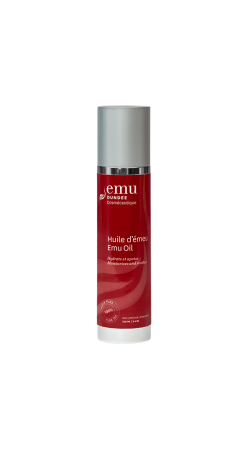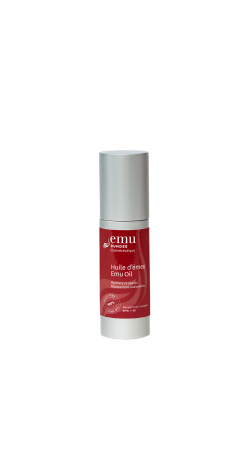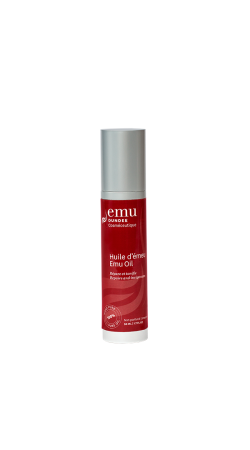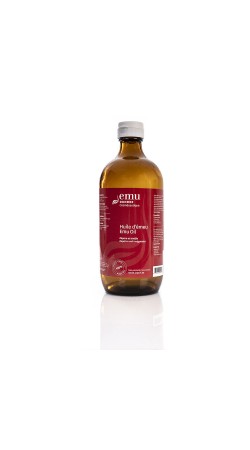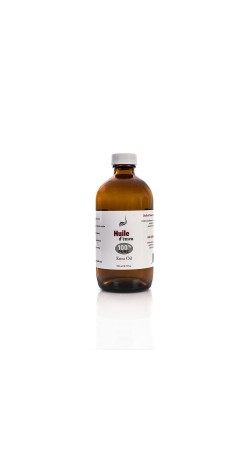What is it?
Emu oil has been a staple in traditional Aboriginal medicine for centuries and is used to treat pain, skin conditions and burns.
Why does it work?
Emu oil is prized as a cosmetic product because it penetrates deep into the skin. Unlike other vegetable and animal-based oils, emu oil leaves no greasy residue on the skin. Unlike all other oils sourced from animals, emu oil contains no phospholipid molecules (phosphorus), which is why the oil is absorbed by each layer of our skin (epidermis, dermis and hypodermis). Thus, the oil penetrates transdermally or transcutaneously, which allows for
The 5 benefits
of emu oil
1 Anti-inflammatory
2 Hydrating
3 Healing
4 Anti-bacterial
5 Anti-ageing
Why does it work?
Emu oil is prized as a cosmetic product because it penetrates deep into the skin. Unlike other vegetable and animal-based oils, emu oil leaves no greasy residue on the skin. Unlike all other oils sourced from animals, emu oil contains no phospholipid molecules (phosphorus), which is why the oil is absorbed by each layer of our skin (epidermis, dermis and hypodermis). Thus, the oil penetrates transdermally or transcutaneously.
The 3 advantages of emu oil
- Hypoallergenic
- Non-comedogenic
- Transcutaneous (its composition is similar to human sebum)
The cosmetic and medicinal strengths of emu oil are naturally due to its unusual composition. The final composition of emu oil varies according to breeding conditions. Our emu oil is made up of:
- oleic acid (55%)
- linoleic acid (15-20%)
- palmitoleic acid
- linoleic acids
- palmitic acids and stearic acids (30%)

In reality, there is no need to add to or transform emu oil in order to increase its effectiveness. Emu oil is naturally rich in omegas 3, 6, 7 and 9, which are all essential fatty acids.
These essential fatty acids fulfill functions that are essential since our body needs an external source to absorb them. Omega 3 oils are particularly useful because they stimulate the cell membranes and boost their regenerative properties by reducing inflammation. Omega 6 oils also soothe inflammatory reactions and speed up the skin healing process. Omega 9 oils are the only omega oils that we can synthesize from saturated fatty acids found in other foods (meat, dairy products, etc.). Omega 9 oils are very useful for countering cardiovascular issues and reducing bad cholesterol.
How should I store pure emu oil?
Emu oil is made up of fatty acids so it should not come into contact with air in order to maximize its shelf life. Ideally, it should be stored in an airtight container in a dry location and never be exposed to sunlight. Emu oil can be used several months after its expiry date if it was stored correctly.
How can I choose a high-quality emu oil?
1 Manufacture
Emu oil is extracted from one animal-based element: emu fat which is primarily located on the emu's back. After the fat is filtered, the precious raw material is sent to a factory where it is melted and rendered. The result is raw emu oil. Once water and natural contaminants have been filtered, the emu oil is refined. The refining process eliminates the oil’s disagreeable odour which is caused by an excess of metals and fatty acids. The final stage involves injecting steam into the oil to eliminate the remaining odour-causing bacteria and sterilize the liquid.
The resulting pure emu oil is white, almost clear and has a liquid texture that liquefies even more when exposed to heat.
Manufacturing best practices ensure that standards are respected when it comes to testing, manufacturing, storage, handling and distribution of natural health products. They apply to the following elements:
- product specifications
- premises
- equipment
- staff
- hygiene
- production
- quality control
- stability
- ledgers
- sterile products
- samples or manufacturing batches
- reports on product recalls
2 Labelling
All products sold in Canada must meet labelling requirements for safety reasons.

Our labels show:
- the product name
- product licence number
- quantity of product per unit (as applicable)
- complete list of medicinal and non-medicinal ingredients
- recommended use (including purpose or health claim, route of administration and dose)
- any cautionary statements, warnings, contraindications and possible adverse reactions associated with the product
- any special storage conditions
3 Licencing
All natural health products must have a product licence before they can be sold in Canada. To get a licence, applicants must give detailed information about the product to Health Canada, including: medicinal ingredients, source, dose, potency, non-medicinal ingredients and recommended use(s).
Once Health Canada has assessed a product and decided it is safe, effective and of high quality, it issues a product licence along with an eight-digit Natural Product Number (NPN) or Homeopathic Medicine Number (DIN-HM). This number, which must appear on the label, lets you know that the product has been reviewed and approved by Health Canada.


